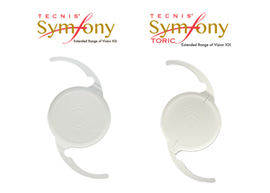TECNIS® SYMFONY IOL- EXTENDED RANGE OF VISION IOL

The latest addition to the TECNIS® Family of IOLs offers new optical technology for providing an Extended Range of Vision.
Traditional IOL solutions for treating presbyopia include Multifocals and Trifocals, which work on the principle of simultaneous vision by splitting light into multiple distinct foci, and Accommodative IOLs, which change in shape and power when the ciliary muscle contracts. Traditionally with these technologies, the correction of presbyopia is commonly thought of in terms of the distinct distance for which functional vision is provided.
KEY NEEDS FOR PRESBYOPIA-CORRECTING IOLS :
- High patient satisfaction by providing reliable outcomes
- Low number of complaints (on refractive outcomes or halos and glare)
- No significant additional chair time
Many people who have cataracts experience other problems with their vision, such as presbyopia and astigmatism, which the Symfony lenses also address.
Presbyopia, which affects most people over age 40, means people have lost the ability to focus on objects up close and often require glasses to perform near visual tasks. Astigmatism is when the cornea is misshapen, which causes blurry or distorted vision.
The Symfony intraocular lens is a new option, we can offer to improve patient’s vision following cataract surgery, especially those who have difficulty focusing on objects at near distances because of presbyopia. Many patients live very active lifestyles and want to see clearly at all distances, and without glasses if possible. With the Symfony lens, we can give patients the freedom to enjoy the activities that matter to them, while wearing glasses less.
During cataract surgery, the natural lens of the eye is removed, and an artificial lens, called an intraocular lens, or IOL, is inserted into the eye. The IOL most commonly used in cataract surgery is a monofocal lens, which only allows the person to see at a distance, with closer objects being out of focus. In contrast, the Symfony lens was specifically developed with features to improve both the range and quality of vision.
We are focused on improving people's vision and their lives by helping them stay healthy and active. Symfony offers patients, including those with astigmatism, an option for crisp, clear vision at all distances. This is an important addition to our portfolio of lenses, as we expect many patients to choose a Symfony lens over a standard monofocal lens, given its benefits. We are happy that we can offer more people around the world this new category of lenses.
The Symfony lens is approved in more than 50 countries around the world, and has been widely studied, with data from numerous clinical studies involving over 2,000 eyes. In clinical studies, the Symfony lens :
- Provided seamless, day-to-night vision : Patients could see objects sharply and clearly at near, intermediate and far away distances, and points in between.
- Provided high-quality vision : Some IOLs may leave patients with an inability to focus clearly due to competing wavelengths of light passing through the lens at different angles (known as chromatic aberration), or with vision that is not completely focused because of the shape of the lens (known as spherical aberration). The Symfony lens has been engineered to correct these issues.
- Demonstrated a low incidence of halo and glare : Which may be perceived as rings or blurring around bright lights. Glare and halo can sometimes affect an individual's ability to drive at night or to perform other visual tasks.